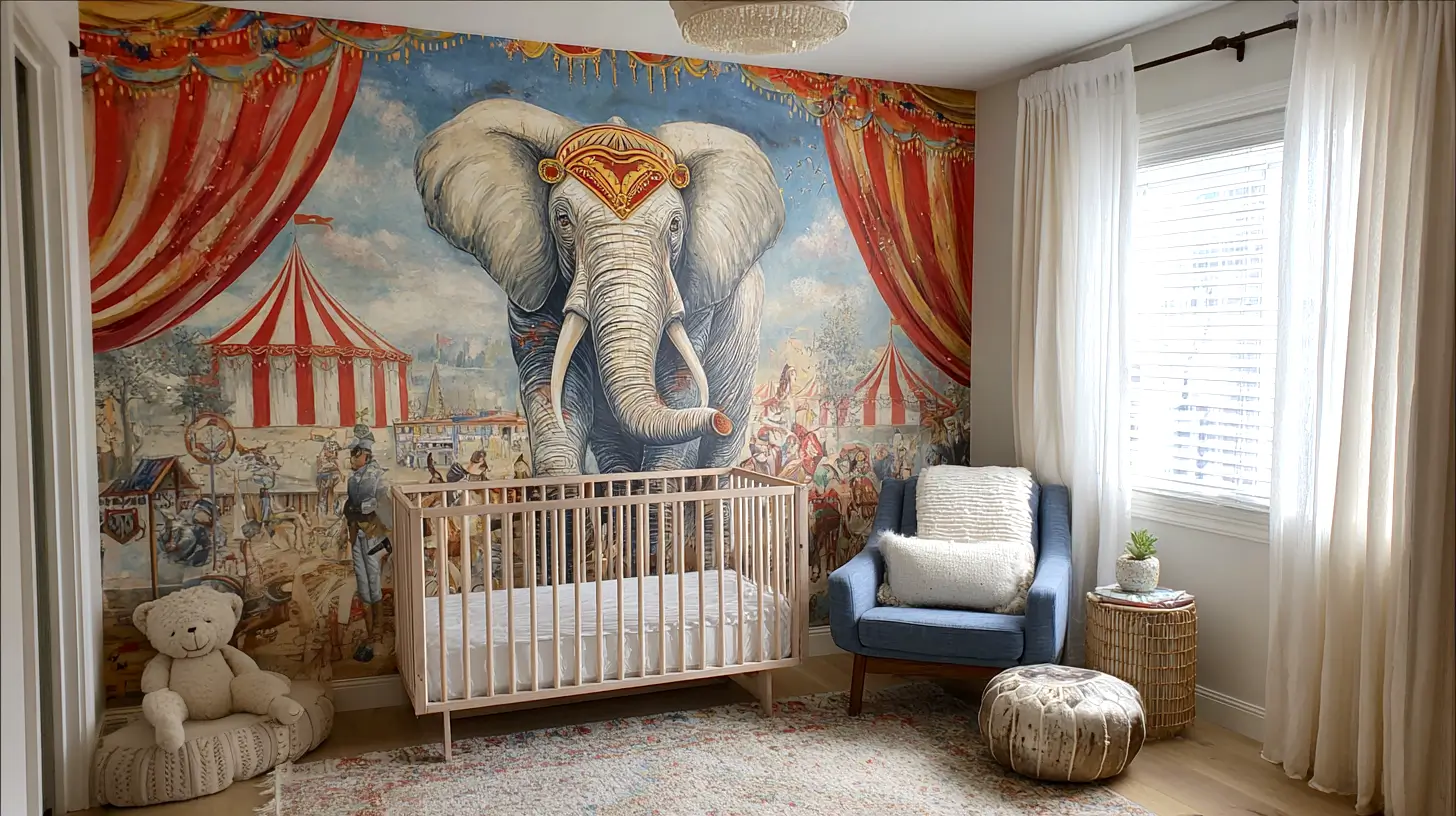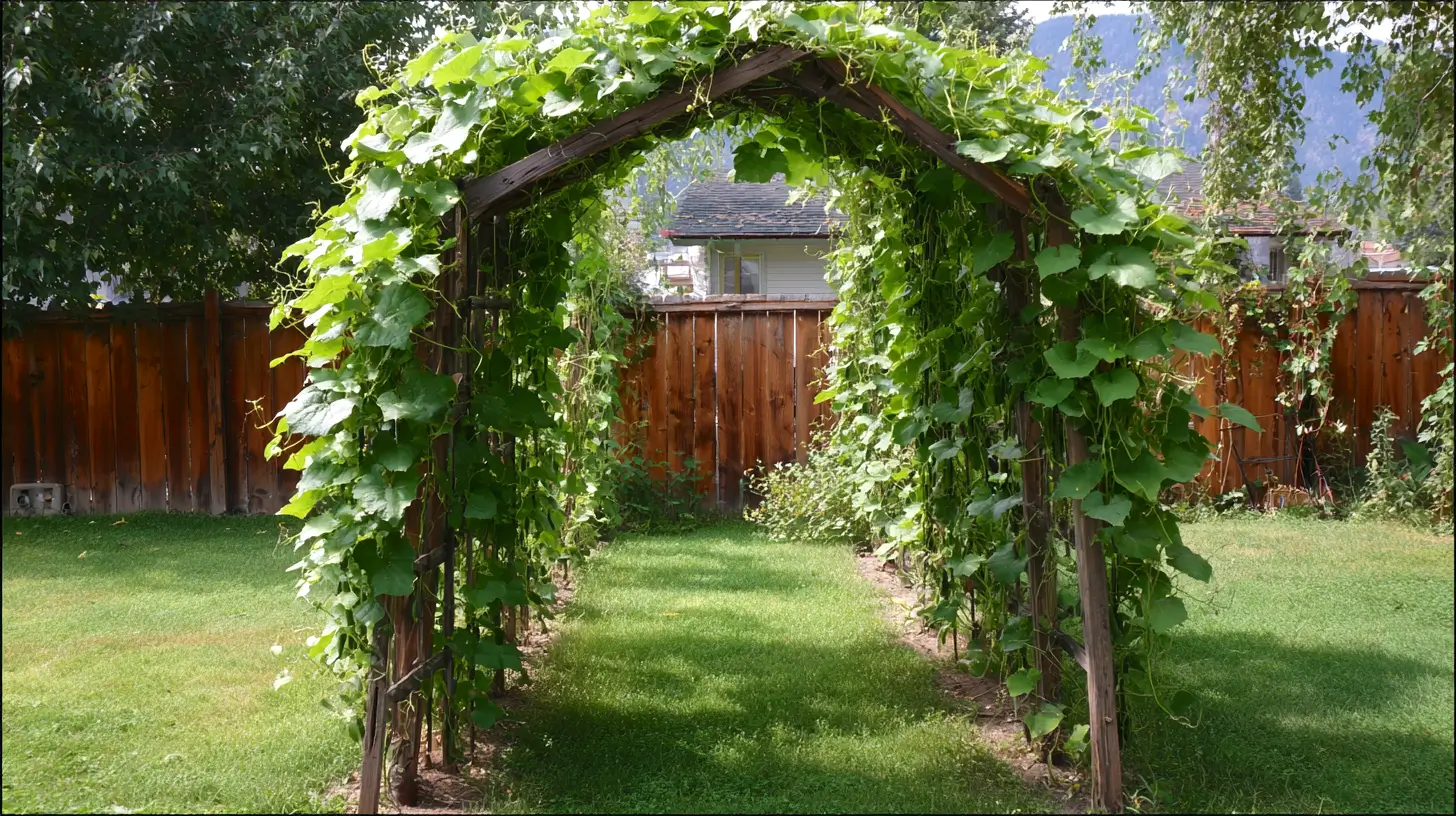Our HOA requires us to keep a lawn. So I can’t go full no grass backyard, even if I wanted to. But I’ve looked into it enough times to know that skipping the grass altogether can be a real money-saver—and a lot less work too.
Between the watering, mowing, and feeding, grass can become one of the most high-maintenance parts of a home. And for what? It gets patchy. It dries out. And if you’ve got pets or kids, it doesn’t always hold up anyway.
I started looking into grass alternatives because I wanted low-maintenance ideas that still looked nice. I also wanted options that didn’t cost a fortune. It turns out, there are tons of ways to design a no grass backyard that’s affordable, low-effort, and family-friendly.
If you’re tired of lawn care, or you’re allowed to skip grass altogether, this post will walk you through smart alternatives. These ideas work whether you’ve got a big yard or a small one, and they’re budget-conscious too. Some are DIY-friendly. Some involve recycled materials. And some are just plain clever.
Whether you’re dreaming of a no grass backyard or just want to cut down on the lawn you’re stuck maintaining, these practical options can help you get started without breaking the bank.
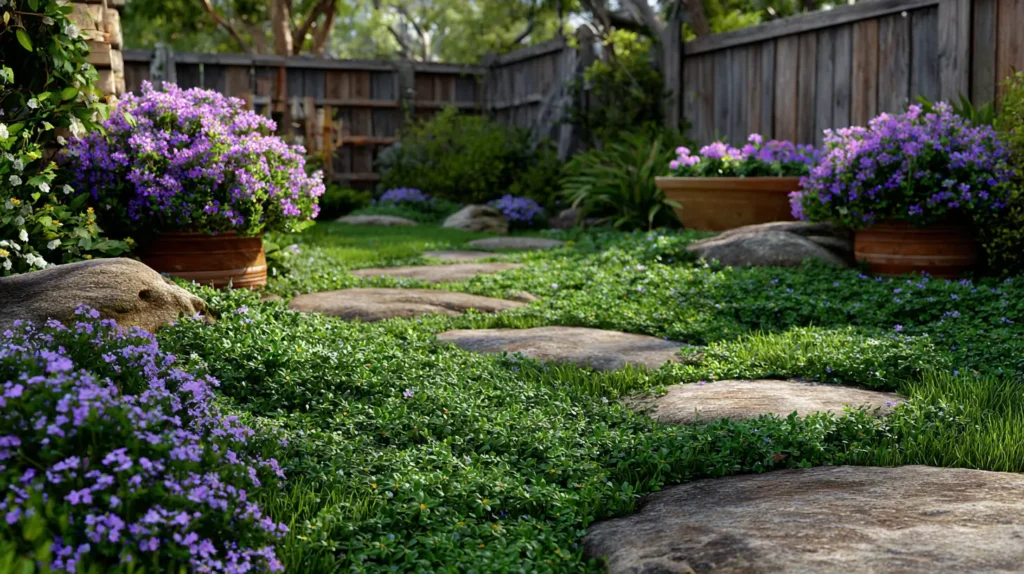
This site includes affiliate links; please take a look at the disclosure for more details.
Gravel Is One Of The Most Affordable Options
Gravel is one of the easiest and cheapest materials to use in a no grass backyard. It spreads easily, drains well, and doesn’t require ongoing care like mowing or watering.
It’s also versatile. Crushed granite is great for patios and sitting areas. Pea gravel looks a little more decorative and works well around garden beds. You can use larger rocks for dry creek beds or side yard drainage.
Here’s why gravel is such a smart choice:
- It’s usually cheaper per square foot than concrete or pavers
- You can install it yourself with a shovel and rake
- It lasts for years with very little upkeep
To make it even more frugal, some people use cardboard boxes as a weed barrier instead of landscape fabric. It works surprisingly well and costs nothing. You can also look for gravel in bulk at local rock yards. Many places offer delivery or discounts if you buy more at once.
A gravel area can become a cozy seating spot, a base for container gardens, or a walkway. Just add a few pavers or edging to keep it from spreading.
If you’re planning a no grass backyard and need a budget option that still looks great, gravel is definitely worth considering.
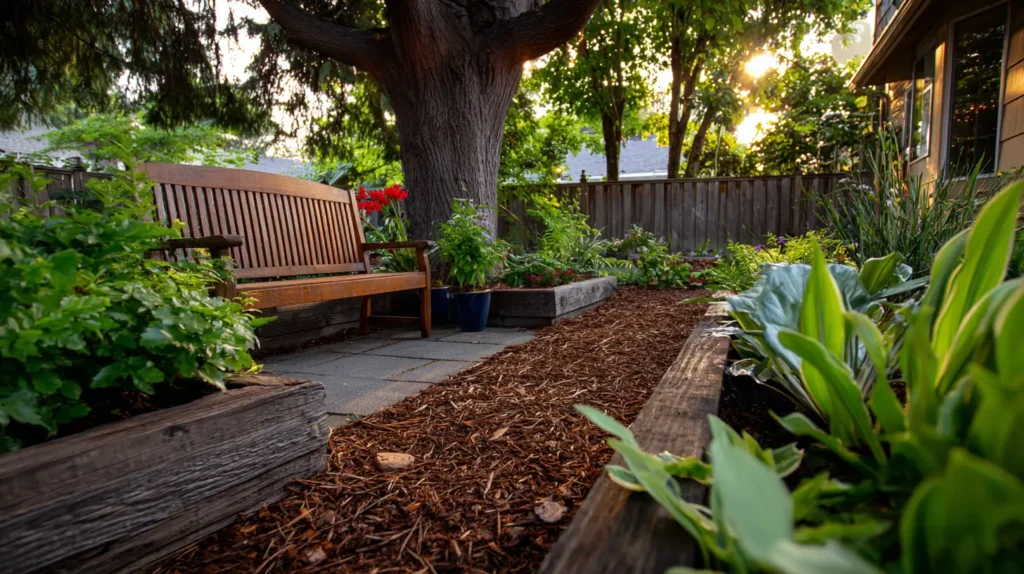
Mulch Is A Budget-Saver That Makes Everything Look Clean
Mulch might not seem like a lawn replacement, but it’s surprisingly effective. It’s low-cost, low-maintenance, and makes any space feel finished.
It also works in a lot of different places. You can use it under trees where grass won’t grow, around raised garden beds, or as a full-ground cover in small yard areas.
A few frugal mulch ideas:
- Get free mulch from your city’s yard waste program if they offer it
- Ask tree-trimming companies to drop off a load of fresh chips
- Check Facebook groups or buy/sell pages for giveaways
To keep weeds down, some people lay cardboard or newspaper underneath. Then they pile mulch on top. This combo blocks sunlight, keeps the area neat, and breaks down naturally over time.
Mulch looks especially nice when combined with:
- Stepping stones
- Flower containers
- Simple wood or brick edging
It also adds great contrast to green plants, making your garden pop without needing a full lawn underneath.
If you’re trying to create a no grass backyard that still feels soft and natural, mulch is a solid, affordable option. It smells good, it looks clean, and it saves money long-term.
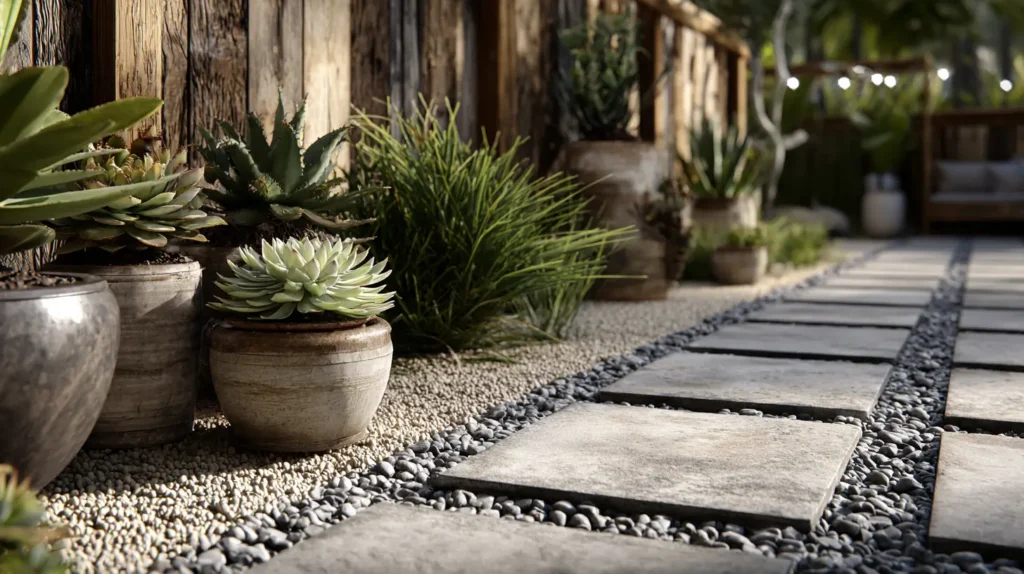
Pavers Are Perfect For Low-Maintenance Backyard Zones
Pavers are one of the best alternatives to grass if you want your yard to feel structured. You can use them to create patios, walkways, or seating areas—and they don’t require constant upkeep.
They’re also easy to customize. You can lay them close together for a solid surface or space them out with gravel in between. Some people even add creeping thyme or moss between pavers for a softer look.
Pavers can be frugal too.
- Look for discounted or overstocked pavers at home improvement stores
- Search for secondhand or leftover materials on Marketplace
- Make your own pavers with concrete molds and a few bags of mix
If you go the DIY route, use sand or decomposed granite to level the ground. Then lay the pavers in your pattern of choice. It’s a weekend project that makes a big difference.
Ideas for using pavers:
- A dining patio under string lights
- A clean path through mulch or gravel
- A small sitting area around a fire pit
For anyone designing a no grass backyard, pavers are a great way to add polish without adding hassle. They’re durable, good-looking, and simple to install on your own.
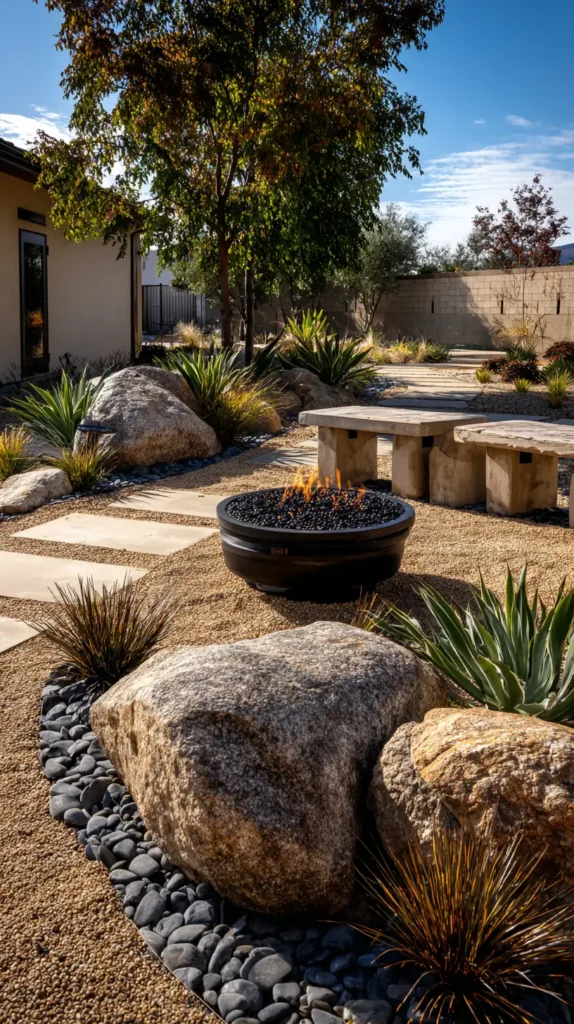
Decorative Rock Adds Style With No Maintenance
Decorative rock might not seem exciting, but it adds major impact to a no grass backyard. It’s low-maintenance, affordable, and holds up well over time. You can mix colors, shapes, and sizes to get the look you want.
Popular options include:
- Pea gravel for a softer, rounded look
- Crushed granite for a modern, compact surface
- River rock for borders or around garden beds
You can use decorative rock to fill space, prevent erosion, or create visual interest. It’s especially helpful in tricky areas like slopes or places that stay damp.
Money-saving tips:
- Buy in bulk if you’re covering a large area
- Ask about broken bags or small-load discounts
- Use cardboard instead of weed barrier under the rock
Rock is also great for outlining zones. You can use it around the base of trees, under a bench, or near container gardens. It adds texture and makes everything feel more put together.
For a no grass backyard, decorative rock is a smart way to avoid constant maintenance while still getting a polished, pretty finish.
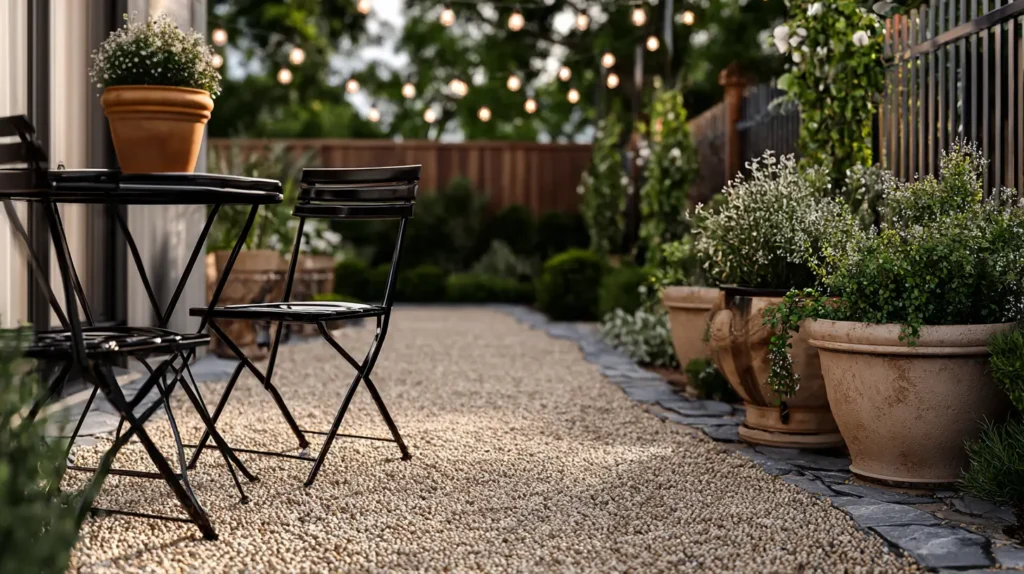
Use Containers To Bring In Green to a No Grass Backyard
Container gardening is one of the easiest ways to make a no grass backyard feel full of life. You still get color and greenery, but without all the work that comes with a lawn.
It’s also very flexible. You can move the containers around, change them with the seasons, and scale up or down as needed.
Start with basic containers—whatever you have on hand:
- Buckets with holes drilled in the bottom
- Large storage bins cut down to size
- Old pots picked up at garage sales or thrift stores
What you plant is totally up to you. Hardy herbs like basil or mint do well in small pots. You can also grow flowers, tomatoes, or succulents depending on your climate.
To save even more:
- Use sticks, pinecones, or leaves to fill the bottom of big pots
- Swap cuttings with friends instead of buying new plants
- Paint mismatched pots to match your backyard colors
Containers are great because they let you add life to patios, gravel paths, or paved spaces. They also work well in small yards where digging isn’t an option.
If you’re building a no grass backyard on a budget, container gardening gives you a low-cost way to keep things green without needing a full lawn.
Use Salvaged Materials To Create Hardscape Features
If you want your backyard to feel put together without spending a fortune, salvaged materials are a smart way to go. With a little creativity, you can build useful features using items you already have or can get for cheap.
Here are some great materials to reuse:
- Old bricks or pavers from past projects
- Cinder blocks for planters or benches
- Wood pallets for seating areas or decks
Places to look:
- Facebook Marketplace or local swap groups
- Habitat ReStore or local surplus stores
- Construction sites (ask first!)
Simple ideas that make a big impact:
- A small fire pit built from old bricks
- A bench made from stacked cinder blocks and a wood plank
- A path created with broken concrete pieces (“urbanite”)
Reusing materials not only saves money, it also adds charm and personality. You’re not just buying something off the shelf—you’re creating something unique.
For a no grass backyard that’s budget-conscious and full of character, salvaged materials are worth digging through.
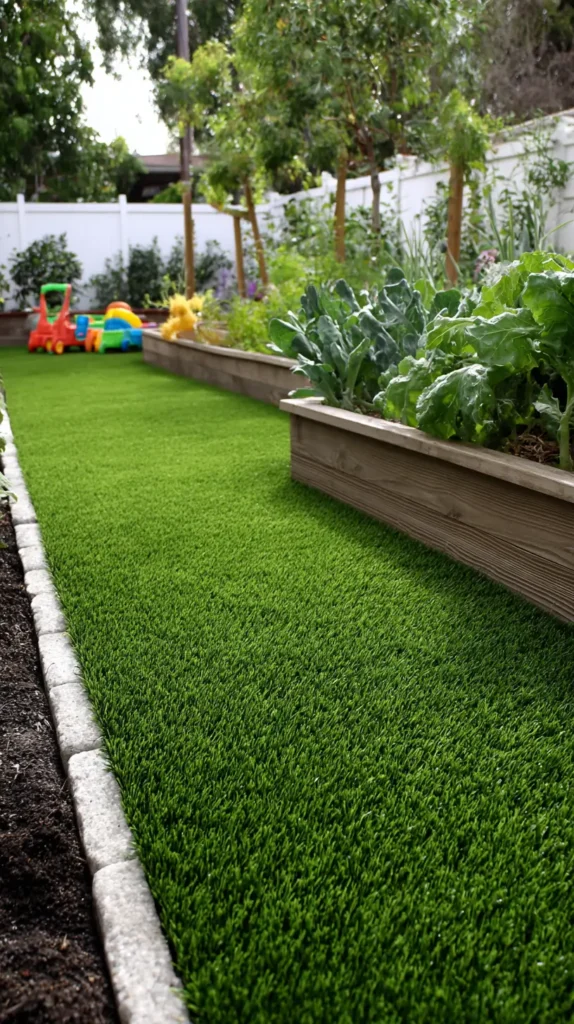
Artificial Turf Can Work In Small, Strategic Areas of a No Grass Backyard
Artificial turf isn’t the cheapest up front, but in the right spot, it can be a low-maintenance win. Especially if you’re not covering your whole yard. I’ve looked into it more than once for those high-use zones—like side yards, pet runs, or narrow strips that are always muddy.
The benefit is that it stays green without watering or mowing. No weeds. No fertilizer. Just a hose-off now and then to keep it clean. Some people even use it under play structures or outdoor furniture so there’s a soft landing underneath.
Here’s where turf makes the most sense:
- In small areas where real grass won’t grow
- Where kids or dogs run often and create dirt patches
- Around patios or decks to soften the hardscape
Frugal tips:
- Buy remnant rolls from landscaping suppliers or home improvement stores
- Use turf only in accent areas, not the entire yard
- DIY the installation if you’re comfortable digging and leveling
One note: make sure to install it over a solid, compact base with proper drainage. That helps it last longer and keeps it looking good. If installed correctly, quality artificial turf can last 10–15 years.
While a full yard of turf might not be practical for most frugal projects, using a small patch in your no grass backyard can strike the perfect balance. It keeps things green where it matters, without needing the maintenance or ongoing cost of real grass.
Ground Cover Plants Add Green Without the Hassle
If you still want a green look without dealing with traditional lawn care, ground cover plants are a great option. These low-growing plants spread across the soil, keeping it covered without mowing or watering constantly. Some are even drought-tolerant.
I’ve come across so many varieties while researching no grass backyard options, and there’s something for almost every climate. Some stay tight to the ground and give a carpet-like look. Others bloom with tiny flowers, adding color without fuss.
Here are some popular ground covers to consider:
- Creeping thyme: fragrant, hardy, and handles foot traffic
- Clover: soft underfoot and doesn’t need much water
- Corsican mint: tiny leaves and a fresh scent in shaded areas
- Sedum: perfect for dry, rocky areas and spreads well
A few frugal planting tips:
- Look for small starter pots or plugs—they spread quickly once planted
- Trade cuttings with neighbors or local gardening groups
- Space them out and let them fill in naturally to save money
Ground cover plants are especially nice around patios, between stepping stones, or in shady corners where grass never thrives. They add texture and life without requiring a lawn mower.
If you’re going for a no grass backyard that still feels lush and green, ground cover is a smart and affordable compromise. You get the soft, natural look without the regular watering, trimming, or fertilizing that grass demands.
Final Thoughts on a No Grass Backyard
While I’m not allowed to go lawn-free in my own yard, I’ve spent enough time looking at the options to know this: a no grass backyard is easier, cheaper, and more flexible than most people think.
You don’t need to spend thousands or hire a landscaper to make your yard work better for your family. Whether you use gravel, mulch, pavers, or just a bunch of flower pots and some clearance patio furniture, there’s always a budget-friendly way to make your outdoor space feel more usable.
I love seeing creative backyard setups on Pinterest where people skip the lawn and still make it feel cozy and complete. Some of the best ideas come from folks who use what they already have—like leftover bricks, extra buckets, or wood scraps.
If you’re tired of lawn upkeep or just want to try something different, a no grass backyard could be the answer. Whether you’re allowed to go all in or just want to start small, every change makes your yard a little more enjoyable.
You deserve a space that’s simple to manage and fun to be in. Even without grass, you can absolutely make it beautiful—and make it yours.

